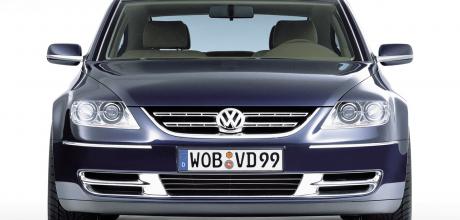2002 Volkswagen Phaeton - it knocked the ball well and truly out of the park

Back in the early 2000s, Volkswagen didn’t just dip its toe in the luxury saloon market with its flagship Phaeton, it knocked the ball well and truly out of the park!
BIG JOBS THROW BACK
For this month’s throwback we revisit the legendary Volkswagen Phaeton; a refined and uncompromising car that marked VW’s intrepid step into the early 2000’s luxury automotive market. But the Phaeton was no mere dipping of the toe into the high-end pool; it was a bold leap that saw no expense spared. From technology, to interior materials, to paint quality, to drivetrain, Phaeton was designed to stand head and shoulders above even the most well-established rivals.
In the late 1990s, Ferdinand Piëch’s time as Volkswagen AG CEO was nearing an end. Rather than quietly fade into retirement, Piëch pursued an ambition of introducing a Volkswagen model to the luxury segment. An early look at the shape that ambition would take was the Concept D sedan Volkswagen brought to the 1999 Frankfurt Motor Show. The Concept D featured a 5.0-litre, direct-injection V10 engine and directly previewed the look of the Phaeton—save for the hatchback element of its design. Just two years later, the Phaeton would enter production, looking to establish itself among other luxury sedans of the day through a combination of superior comfort, technological advancements, and performance from a wide range of engines.
Such was Volkswagen’s commitment to the Phaeton, in fact, that an entire facility — the “Transparent Factory” in Dresden — was built especially for its production. At the Dresden factory, the construction of the Phaeton in itself was unlike anything else in the automotive world: components of the luxury sedan would arrive as sequenced deliveries immediately before assembly. Parts and modules would traverse the factory in boxes via a driverless transport system, and an electric overhead conveyor would bring each Phaeton through the three vertical levels on which it would be assembled. The precision, compartmentalisation, and extraordinarily clean environment of the “Transparent Factory” resulted in truly world-class construction for Volkswagen’s world-class luxury sedan.
Initially, the Phaeton came standard with a 3.6-litre V6 engine. Another Piëch project of the day, a 6.0-litre W12 engine, was available as an option. The W engines were just beginning to see their way into production at this time: the Passat had an optional W8, and the W12 available in the Phaeton could be found in new Bentley models or as an option in Audi’s A8 luxury sedan. A V10 diesel option became available in 2003, followed by a six-cylinder diesel and a V8 gasoline engine. 4Motion all-wheel drive was standard issue in W12 Phaetons, and all models featured an advanced air suspension, outstandingly comfortable seats, and a draft-free automatic climate control system.
Even the air conditioning system on the Phaeton was an achievement. Along with a humidity-monitoring function to avoid the vehicle misting up, the Phaeton W12’s four-zone climate control system was designed to be capable of maintaining a steady interior temperature of 72 degrees Farenheit while the vehicle held a constant speed of 186 mph at an ambient temperature of 122 degrees. The climate control systems, aerodynamics, brakes, suspension, steering system and even wipers were designed to cope with speeds far exceeding the typically-regulated 155 mph. As unlikely as one might be to find themselves requiring such performance, the Phaeton still stood ready to deliver.
But the Phaeton found difficulties in breaking through to a status-sensitive American audience. As impressive as it was, a segment crowded with long-established luxury makes and models constricted its success, ultimately driving it from the American market in 2006. Ironically, the Phaeton has since become something of a cult favourite among enthusiasts in the United States, while its sort of fallen by the wayside here in Europe.
Volkswagen’s big luxury car enjoyed much greater popularity within the German domestic market and around the world, especially in China. In fact, the Phaeton was successful enough in its high-luxury aims that a revised version was released for the 2010 model year, offering a 4.7-inch longer “Executive” interior for those who wished to be chauffeur-driven. The already high level of standard equipment expanded to include 4Motion all-wheel drive in all models, along with Continuous Damping Control (CDC) adjustable air suspension, 18-way adjustable electric seats, and a laminated finish to all glass areas. For the first time on a Volkswagen, the option of Google MapsTM was available on the Phaeton’s satellite navigation system.
The success of the Phaeton in the world market continued into the 2010s: A record 7500 were built at the Transparent Factory in Dresden in 2010, and over 60,000 were produced between 2001 and 2011. Phaeton production was discontinued in 2016, as Volkswagen shifted the resources of the Dresden factory toward a focus on electric vehicles. The e-Golf was assembled at the Transparent Factory from 2017 to 2020 and mass production of the ID.3 EV began in 2021.
«Volkswagen recently shifted the resources of the Dresden factory toward a focus on electric vehicles»
While the future of Volkswagen vehicles might be exciting, sometimes it's important to look at where it all stems from

